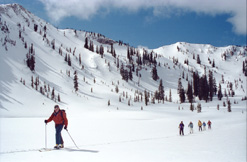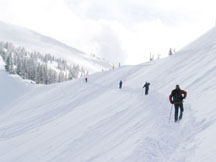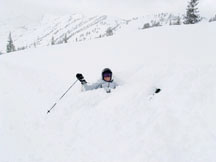Gaining altitude: skiing roughly out of bounds
Confidence a necessity
PARK CITY, Utah -- Eight of us stand at the summit of Jupiter Bowl, where a rope marks the boundary of Utah's Park City Mountain Resort and the backcountry, an area typically off limits to those with lift tickets.
Indeed, the sign next to us says, ''Area closed. Out of bounds."
On this guided trip, however, the goal is to spend most of our time
out of bounds. We will leave behind the ski lifts and groomed
trails, and enter a pristine region where we blaze our own tracks
through knee-deep powder and tune in to the sounds of the wind and
the wintering chickadees.
will leave behind the ski lifts and groomed
trails, and enter a pristine region where we blaze our own tracks
through knee-deep powder and tune in to the sounds of the wind and
the wintering chickadees.
Ski Utah's Interconnect Adventure Tour takes skiers into the heart of the Wasatch wilderness. In one day, we will cover 20 miles as we ski to five resorts -- Park City, Solitude, Brighton, Alta, and Snowbird -- stopping for a few runs at each area. Connecting the resorts by car would require 75 miles, or about 90 minutes of driving. A sixth resort, Deer Valley, has been added to the Interconnect lineup for the 2004-05 season, which runs now through April, weather and conditions permitting.
''This is the only place in North America where you can ski so many resorts in one day," says Rodd Keller, Interconnect's lead guide and a 30-year veteran of off-piste (unpatrolled, unprepared snow) skiing.
Adds Mark Menlove, another guide leading our tour, ''We are also the only group that has permission to ski out of bounds in the Wasatch Range," that permission granted by the Forest Service, a branch of the Department of Agriculture.
The tour is geared to people like us: advanced alpine skiers who have little to no experience exploring the backcountry. Skiers use the lifts at each resort to gain altitude, so there's minimal hiking and traversing along the Interconnect route. However, participants must be in good physical condition, because most of the tour is at altitudes between 8,000 and 11,000 feet. Participants must also be able to handle a variety of snow conditions, which can include deep powder, crud, and crust.

Menlove calms our nerves by giving us a run-down on safety issues and an overview on how to use our beacons and survive an avalanche, all skills we hope we won't have to use.
''Our first line of defense is to stay out of areas that can be dangerous," he says, as he checks to make sure our avalanche transmitters are on.
Another key to backcountry survival is being prepared: A 40-pound pack on Menlove's back contains a radio, cellphone, rope, shovel, avalanche probe, climbing skins, first-aid kit, snow analysis equipment, spare clothes, water, Clif Bars (energy bars), and chocolate.
''Ready to 'drop in'?" Keller asks, as the sun beats down on eight inches of fresh snow.
''Let's go!" someone says, and we slip past the ''Area closed" sign and the resort's ski patrol shack.
Single file, we make our way along a trail that cuts through pine forest and shoots us out several hundred yards later in Big Cottonwood Canyon, a large snow bowl dotted with aspen and firs standing in fresh, untracked powder that buries our skis. From the top of the Wasatch crest, the main divide in this region, we can see 50 miles, including peaks all across the range, the lifts at Solitude and Brighton, and the ridges dividing Big Cottonwood and Little Cottonwood canyons.
As a New Englander, I have the least experience skiing in powder
of anyone
I help Harriot to her feet, and we spend the next hour hop-turning and dinner-rolling down the valley. At the end of our long backcountry descent, we arrive at the base of Solitude Mountain Resort. From here, we catch several lifts (jumping into the ski-school lines to avoid the crowds) and shoot over to Brighton for several runs before returning to Solitude for lunch.
At Last Chance Mining Camp, we kick off our boots and fill up on much-needed burgers, chili, and hot chocolate. Rested and warm, we make our way to the top of the Summit chair, slip past another ''Out of bounds" sign, and prepare for our journey across the Highway to Heaven, a dramatic 1,500-foot traverse along the back side of Solitude's Davenport Peak. ''For some people, this is the white-knuckle part of the tour," says Keller.
With a grade of between 32 and 40 percent, this is prime avalanche territory. It is so steep I can reach out and touch the mountain with my hand. To my left, the slope sweeps down to the Twin Lakes and a small dam. Keller and Menlove wouldn't let us on the slope if they weren't confident we would be safe. Still, they tell us to keep at least 100 feet of space between one another.
As we're about to embark, Menlove adds, ''Also, you don't want to fall here."
It's not that we would tumble down to the frozen lakes at the bottom of the basin. The challenge, if one falls or dinner rolls here, is that the snow is so deep, it is virtually impossible to get up on your own. Jason, another skier in our group, finds this out the hard way, halfway along the route, when he loses his balance, tips over, and spends a frustrating few minutes trying to get up, until our guide helps him.
It takes almost an hour to get across the Highway to Heaven, and we all flop down in the snow atop Twin Lakes Pass to catch our breath and survey the route we've just tackled. Then we drop into Little Cottonwood Canyon and make another long descent to Alta ski area, some of us taking the forested route, others sticking to open spaces with sweeping views of the valley. We linger in Alta, a collective favorite, then shoot over to Snowbird for several final runs of the day, before a van picks us up to bring us back to Park City.
After nearly seven hours of skiing through large forests, in deep powder, and on steep slopes, we're all feeling a lot more confident with our backcountry skills. We agree that you need a healthy sense of adventure and strong alpine skills to do this trip, not to mention a curiosity for exploring what's on the other side of the ropes.
As we're returning our avalanche beacons to Menlove, we also agree that it's great having two guides to show us the way, be there when we need help, and teach us about backcountry travel as we go -- plus offer pointers that will keep the ''dinner rolls" to a minimum.
Kari Bodnarchuk is a
freelance writer in Somerville. ![]()
If You Go: Park City, Utah
How to get there:
The lowest round-trip air fare between Boston and Salt Lake City
at press time was $262 on America West and Delta Airlines. Park
City is an easy 30-minute drive east on Interstate 80, or catch
a shuttle to Park City or Snowbird (see www.parkcityinfo.com
for transportation information).
What to do:
Ski Utah's Interconnect Adventure Tour
801-534-1907
www.skiutah.com
Tours depart Deer Valley on Mondays, Wednesdays, Fridays,
Sundays, and include Park City, Solitude, Brighton, Alta, and
Snowbird ski areas. A circular tour leaves Snowbird on Tuesdays,
Thursdays, and Saturdays, taking skiers to Alta, Brighton, and
Solitude, returning to Snowbird on a different route. The $150
cost of either tour includes two guides, lift access, lunch, use
of an avalanche beacon, and transportation back to the starting
point. Tours run with a minimum of three and a maximum of 12
people.
Rental equipment:
Ski 'n See
Mountain Resort Center, Level 2
Park City
800-722-3685
www.skiNsee.com
Alpine ski rentals $19-$39 per day. Pick up equipment anytime
after 4 p.m. and return it the next night by 8.
Deer Valley Rental Shop
888-754-8477
www.deervalley.com
Rent performance skis for $52 per day (add $10 for a helmet).
Pick up anytime after 4 p.m. and return the next night by 7.
Snowbird's Cliff Sports
801-933-2265
www.snowbird.com
Rent performance skis for $40 per day ($10 extra for helmet).
Pick up anytime after 3 p.m. and return the next night by 8.
Where to stay:
Yarrow Resort Hotel
1800 Park Ave., Park City
800-927-7694
www.yarrowresort.com
Standard hotel rooms and suites in a cozy lodge setting,
$189-$399.
Black Diamond Lodge, Deer Valley Resort
888-976-2732
www.deervalley.com
Offers two- to four-bedroom, slope-side condos. From $560.
Hotel Park City
2001 Park Ave., Park City
435-940-5000
www.hotelparkcity.com
A luxury resort hotel with a mountain lodge feel, within five
minutes of the Park City resorts. Suites from $249.
Crystal Inn
Salt Lake City, Midvalley, Murray
888-685-9300
www.crystalinns.com
Twenty minutes from Snowbird, near the mouth of Little
Cottonwood Canyon, has nice rooms for less than $100.
Cliff Lodge at Snowbird
800-453-3000
www.snowbird.com Offers
slope-side accommodations, ranging from hotel rooms to large
condo units, $179-$279.
Where to eat:
Bangkok Thai
605 Main St., Park City
435-649-8424
Excellent Thai dishes. Entrees $12-$18.
Snow Park Lodge
Deer Valley
435-645-6632
www.deervalley.com
An all-you-can-eat seafood buffet ($50).
Wahso
570 Main St., Park City
435-615-0300
Asian cuisine. Entrees $20-$32.
Chez Betty, Copperbottom Inn
1637 Short Line Road, Park City
435-649-8181
American cuisine in a casual setting. Entrees from $22.
350 Main
350 Main St., Park City
435-649-3140
New American cuisine. Entrees $14-$29.
Apres-ski:
Utah Olympic Park
435-658-4200
www.olyparks.com
Ten minutes from Park City, tour the 2002 Winter Olympics
competition sites, visit the Alf Engen Ski Museum, which
chronicles Utah's ski history, or ride on the world's fastest
bobsled track (with a professional driver) at speeds up to 80
miles per hour.
Sundance Film Festival
Park City
801-924-0882
www.sundance.org
The festival, scheduled Jan. 20-30, showcases many of the best
independent American films and documentaries.
The Viking Yurt
435-615-9878
www.thevikingyurt.com
Guests take a sleigh ride to the yurt for a venison dinner. ![]()